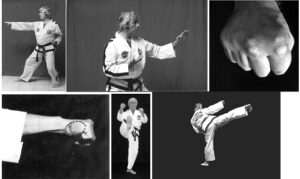
We can talk until tiredness about the biomechanics of Taekwon-Do movements. These are just a variety of tools that we can use for self-defense. The practical usefulness of each of them is closely linked to the circumstances we have to face. For this reason, the vast majority will be of practical use in situations that cannot be reproduced in sports because they have been designed to solve situations with several opponents.
Normally, the confrontation with a single opponent is trained, as the only one possible to be included in the sport field. The pedagogical aspect and its methodology have a central influence for success in this area.
Usually in the teaching of art, students are compelled to execute this type of fight from the very beginning of the practice; I mean that due to an erroneous pedagogy a beginner is required to perform this type of confrontation without an adequate handling of his body for such a commitment.
The beginner is compelled to acquire his experience on the trial and effect of his own blunders. They had not time enough to acquire a better control of the necessary tools.
He is encouraged to execute foot works that include reverse turning kicks and jumps when he is still clumsy for direct linear movements. The reason for this error has a name: tournament.
The «need» of the instructor to take as many students as possible to a sporting event has determined this pedagogical mistake. To illustrate the enormous difference between the bodily employment of an advanced belt and what is done by beginner ranks can be clearly seen in competitions. Not only do they badly hit each other, but they also show the lack of effectiveness in what they do.
Free combat against a single opponent, which is what is taught and executed in daily training, would be used to develop, among other things, tactics and strategy in this type of circumstance. However, the beginner student is forced to not be able to develop them because he doesn’t manage his tools appropriately.
In sport combat, just 6 or 7 techniques out of the almost 3200 existing are used in the best of cases and in hands of a highly skilled person. The regulations, the prohibitions and the type of opponents make it so. The application of these will also depend on time and distance to be successfully executed.
If the student does not yet have mastery of his tools to be able to use them when the occasion demands it, the evolution of his tactics and strategy will be significantly affected.
The solution would be very simple to implement, but unfortunately it will depend on the «need» of the instructor to take his beginner students to a tournament. He must understand, among other things, that if his novice students win, the students of other instructors will not run to enroll in his class.
It should also be clear that if a low-ranking competitor has been a winner in a sporting event, they do not have the development or experience to compete with the more advanced ones, just won in that competition with the occasional opponents of his rank.
The student has always been told that he should not practice a more advanced pattern (tul) until he has mastered the one at his level. This truth is a dictum of the founder of the art himself written in his literature; however this criterion is not applied to the training of sport combat. If the student had not the necessary time to develop the tools, he or she is built on poor foundations, with great ambition but at the wrong time.
SGM Ricardo Desimone